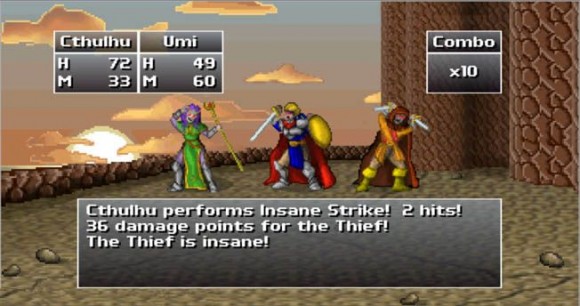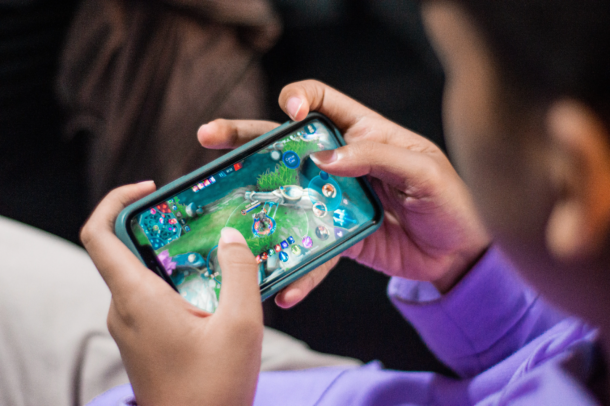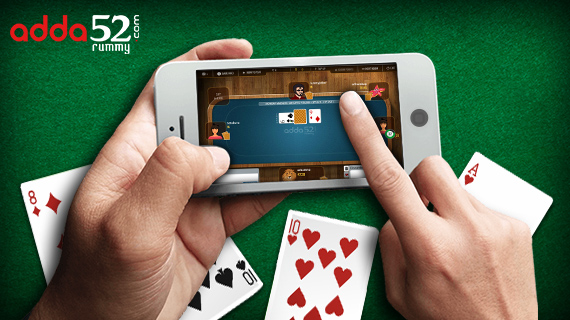iOS Games
Lazy Nostalgia: How Mobile Gaming Could Be a Real Work of Art

 The discussion of whether video games are art or not is one no longer worth having. Games are a form of creative expression and those of us who continue to play them must be getting worthwhile experiences – emotional, mental, or otherwise – out of doing so. The more valid question is whether games are good art or not because, well, not a lot of modern games particularly overextend themselves when it comes to trying to take the medium in unique directions and mostly we’ve got boring, samey games.
The discussion of whether video games are art or not is one no longer worth having. Games are a form of creative expression and those of us who continue to play them must be getting worthwhile experiences – emotional, mental, or otherwise – out of doing so. The more valid question is whether games are good art or not because, well, not a lot of modern games particularly overextend themselves when it comes to trying to take the medium in unique directions and mostly we’ve got boring, samey games.
Much of gaming’s most bizarre, unique, creative, and artistic concepts came from the eighties and early nineties when a title didn’t need several bank accounts emptied into it for it to stand alongside other interactive works. It was more a question of whether one had the skill to work with this fledgling medium and whether they had any idea at all of what to do with it. As such, our gaming forefathers are a decidedly odd bunch, from Mario – a plumber eating mushrooms to grow bigger and jump on turtles – to Guybrush Threepwood, who is named Guybrush Threepwood.
Right now, there’s the potential for a second gaming renaissance. Big budget titles, the majority of which feature hulking manly-men hurting each other with various weaponry, may at present be the face of this medium, but, beyond those, a veritable maelstrom of indie developers have taken to fashioning more modest, yet no less worthwhile titles. This is a fantastic time to be involved in games as, in some respects, we’re back to where we once were. A game can once again be produced with only a few people, some big ideas, and a small budget. Even better, there are more platforms than ever before for these games and, with mobile gaming, the people who discover them can be gamers and non-gamers alike.
Android gaming provides an especially fertile platform due to its lack of a vetting process. Without moderators or the need to work with publishers, anybody can theoretically cobble together a game with the express notion of working toward a vision, rather than a specific demographic. Players are currently more than willing to try out titles knowing they may not be getting something visually or aurally comparable to an AAA console game. In fact, people often flock to these humbler titles specifically for this reason. We all want to see something different. And these indie games are different. Because they’ve adopted a different set of clichés.
It’s depressing enough to witness the state of much of modern mainstream gaming, which (though the roots obviously trace back further than this), can essentially be viewed as the direct product of Resident Evil 4, Uncharted 2, Grand Theft Auto III, and Half-Life. While these were all fantastic, game-changing games, they resulted, predictably, in numerous copycats. Some recent games have taken the formulas established by these titles and done impressive things with them (for example, Spec Ops: The Line seemed to be a criticism of the third-person cover-shooter and series like Infamous and Saints Row took the inherent insanity of sandbox games and indulged in it all the more), but more often we just get lazy attempts at cashing in on current, popular genres.
Since smaller games can’t ever hope to have the cinematic presentation expected from that of the mainstream, we instead end up with various games lazily inspired by the titles of yesteryear. For one, we get a lot of retro pixel art, which usually does nothing particularly new with the style, content to simply recall a bygone era. Games like Fez and Spelunky go for a blocky look that, at one time in gaming, was a necessity due to hardware limitations. Now, it simply looks lazy. You can almost see the ease with which environments were pieced together with a level editor.

Obviously, this is the game these guys wanted to make and this would be fine if a game such as Cthulhu were satisfying a niche, but retro homages (if we choose to label them so kindly) are closer to the norm and titles branching out past this approach are the anomalies. Obviously there’s a benefit to small teams with small budgets using simplistic art, but this is really no excuse for doing a blasé copy job. The unfortunate thing is that the retreading of old concepts triggers nostalgia within us older gamers and that feeling probably suffices for many; simply making a gamer wistful may seem like an artistic feat in itself. However, the joy of the games these titles are ripping from came from the fact was that they were breaking new ground and trying out new ideas with almost every release. This new approach of reheating old game styles is a cheap and in no way novel method of getting inside our hearts.
It’s not as though the past should be completely ignored, but our games should be building upon history, not repeating it. A perfect example of a game doing this right is Superbrothers: Sword & Sworcery EP. Visually, it’s influenced by the pixel art of games from the Commodore 64. However, Superbrothers takes this style and puts its own spin on it, resulting in instantly eye-catching visuals that recall past games while also creating something entirely new. The graphics look as though they took a lot of work with each screen in the game unique to the next, but then this shouldn’t be surprising. Making good art is hard work.

But that isn’t all there is to the game. Superbrothers recognizes that technology is changing and that our interactive media must follow suit. As such, the game actually takes into account the fact that it is being controlled through a mobile device with a touch screen, requiring you to solve puzzles with multiple fingers and including inventive little touches like having you turn your device vertically to unsheathe your sword. The beauty of Superbrothers is that its look and the way it’s played are so completely fresh that it brings new concepts to those who typically game as well as those who do not. There are so few games that I feel confident in being able to recommend to gamers and non-gamers alike, but this is one of them. Again, there are references in it that will make old-school gamers smile, but being a gamer is not a prerequisite to enjoyment. This is art more people can appreciate because there are various ways to appreciate it. This is good art.
The problem of alienating non-gamers is something of an epidemic in this industry and is the result of a number of factors. A big part of it is that so much of gaming is just a boring copyfest. If this stuff hasn’t been intriguing to previously uninterested parties, why would revisiting it make them care now? Additionally, the indie scene has even managed to quickly create new clichés as there seems to be a new movement of developers functioning under the notion that black-and-white graphics coupled with a semi-morose, piano-centric soundtrack automatically equates to being artistic.

Contrastingly, Contre Jour feels like it chose two random elements and stuck them on top of uninventive game mechanics that are immediately reminiscent of another recent (and admittedly fun) game, Cut the Rope. But Cut the Rope just feels like a whimsical little puzzle game that wasn’t aspiring to be morose or moving whereas Contre Jour has the audacity to suggest you put your headphones on at the start for the most engrossing experience. Of these two, Cut the Rope is actually the better work of art. It’s basic, fun gameplay, so its visuals and music follow suit. Contre Jour’s presentation does not mesh with its gameplay. It just feels like the art, graphics, and gameplay happen to be in the same place at the same time by accident.
The problem here is that this sort of approach fools a lot of gamers because we’re so used to our art being subpar. Googling Contre Jour will reveal numerous pieces citing the game as an example of an artistic achievement in gaming when it’s actually just an average (though essentially solid) physics puzzle game that sounds and looks “sad.” Not that black-and-white graphics can’t be artistic. For example, the platformer, Limbo, used them effectively, but Limbo was centered on the depressing concept of a static existence beyond death and, again, this is working toward a singular vision. Minimalist, colorless environments seem appropriate in this case. Also worth mentioning is that Limbo opts for an ambient soundtrack consisting mostly of effects rather than music. It doesn’t try to force you to feel anything by cramming strings and pianos onto its soundtrack. Those might work in some media, but the developers of Limbo recognized their theme was minimalism and loneliness and created their soundscape in service of that.
When these things work together well, it’s something more of us, not just us gamers, are able to feel. Too many of us too deep into this medium to be objective are easily moved (or think we’re moved) by seeing nostalgic refurbishments of images and ideas from our past or by the removal of color from graphics or the addition of pianos to soundtracks. However, for people to whom video games do not yet seem a viable art form, this stuff is either completely foreign or just average. In the world of film, Kevin Smith pulled the black-and-white retro look way back with Clerks and sad scores show up in almost every dramatic picture out there. If we want to make something more worthwhile—both for those who typically game as well as those who do not—we need to put sincere effort into considering what specifically our medium can do that will be unique, novel, and beautiful.

Cherry-picking concepts and art from other works and dropping them into your own is a bad way to do art. As a developer, you should work toward a singular vision that would be fun and interesting for you as a gamer, sure, but even just as an individual. What fascinates you? What interests or troubles you? What are ways you can express or address these issues that you cannot in other media? And remember that, with mobile gaming, you’re working with a portable platform that allows for heretofore unexplored methods of interaction.
The tools to make something new and better are available, so stop trying to make art that just makes gamers remember older, better art. Make something actually interesting. Make something genuinely enjoyable. Make something beautiful. Make something fun. Make something great. Make good art.
Article by Joe Matar, lead contributor and reviews editor at Hardcore Droid (www.hardcoredroid.com). He hasn’t stopped gaming ever since he first played Zak McKracken and the Alien Mindbenders for the Commodore 64. He is always on the lookout for solid game narratives and never gets tired of writing about the games that do it right. Or terribly wrong.
iOS Games
Best iPhone Casino Games for Real Money in Canada

Since most Canadians prefer playing casino games on their smartphone, online casinos have optimized their sites to ensure you have a seamless gaming experience. Moreover, some sites now have dedicated apps for Android and iOS. These apps are optimized to ensure the graphics and visuals remain unchanged regardless of the screen size. In this article, we will discuss some of the casino games you can play on your iPhone either via the iOS app or using a mobile web browser such as Safari.
How to Choose an iPhone Casino
While most casino sites today are optimized for mobile devices, not all iPhone casinos provide the same level of service, game variety, or reliability. To ensure a positive experience, Canadians should keep several key factors in mind when selecting a mobile casino.
Licensing is the first and most important consideration. Make sure the platform is legally registered with a recognized authority, such as the Kahnawake Gambling Commission or iGaming Ontario. These regulators enforce standards that protect players and ensure games are fair.
The selection of games is another critical factor. A strong mobile casino should feature a broad mix of options, including online slots, live dealer tables, and specialty games. Games developed by trusted providers like NetEnt, Microgaming, or Playtech usually come with better visuals, faster gameplay, and a more trustworthy reputation.
Bonuses often come in handy, especially if you are looking to boost your account. However, some offers have strict terms and conditions. Look for casinos that provide generous bonuses with transparent and reasonable wagering terms. Regular offers like reload bonuses, free spins, and loyalty rewards also enhance the gaming experience.
Reliable customer service is essential, especially when it comes to resolving technical issues or questions about withdrawals. The best iPhone casinos offer 24/7 customer support through live chat or email, ensuring assistance is always within reach.
Best Casino Games for iPhone in 2025
iPhone users in Canada have access to a wide selection of high-quality real-money games. These games are optimized to work seamlessly on iOS, delivering responsive touch controls, HD visuals, and fast loading times.
Online slots are among the most popular game categories available to iPhone users. With thousands of themes to choose from, players can go on mythical adventures, visit ancient civilizations, or enjoy modern action-packed storylines. Game types range from simple three-reel machines to feature-rich five-reel titles with dynamic paylines, multipliers, and bonus rounds. Many also come with high Return to Player (RTP) rates and the chance to win progressive jackpots.
Many Canadians also take advantage of free slots offered by mobile casinos. These demo versions allow you to try out games without spending real money. The gameplay, bonus rounds, and features are the same as in the full versions, making them ideal if you want to learn the rules or simply want to play for fun with no risk. Free slots are a great way to try new titles before deciding to wager real funds.
Roulette is another favorite among Canadian players. Whether you’re spinning the wheel on an RNG-based game or interacting with a live dealer, iPhone apps provide a realistic casino experience. RNG versions rely on certified algorithms to ensure fairness, while live dealer games allow real-time interaction with professional croupiers. Popular options include European Roulette, Premium French Roulette, and Immersive Roulette.
Blackjack also ranks high on the list of top iPhone casino games. The goal in this game is to get a hand value closer to 21 than the dealer without going over. Mobile blackjack titles often feature polished interfaces and variations that adjust rules and odds slightly. Multi-Hand Blackjack and Atlantic City Blackjack are well-suited for both beginners and seasoned card players.
Baccarat is another excellent choice for iPhone users who enjoy card-based games with simple rules. It involves predicting whether the banker’s hand or the player’s hand will be closest to a total of nine, or if the round will result in a tie. Both live dealer and virtual baccarat games are available in Canadian iPhone casinos, often with flexible betting ranges to accommodate all player types.
Poker enthusiasts are not left out. Many iPhone casinos feature a solid lineup of video poker titles, such as Jacks or Better and Deuces Wild. These games mix strategy and speed, offering single-hand and multi-hand options along with bonus features.
How to Choose an iPhone Casino
To find the best iPhone casinos, it is advised to test several sites to ensure they meet your preferences. Start with a background and security assessment. Verify the casino’s licensing credentials, partnerships with software providers, and the use of SSL encryption for data protection. This ensures the platform is safe for real money play and secure when handling sensitive information.
Next, test the deposit process. This will help you understand how fast and smooth the transaction is. Additionally, check the available payment methods, including cards, e-wallets, and crypto, as this will give you flexibility to select the most convenient option.
After you’ve deposited, explore the casino’s game library. The best iPhone casinos offer a range of games, including popular slots, table games, and live casino games. Also, test the compatibility of these games on your iPhone to confirm that all games load properly and perform without lag or glitches.
Customer service is another key aspect to consider. You can contact the support team through available channels to check response times and overall helpfulness. This step is critical, especially if you run into issues with payments or gameplay.
Featured
Horse Racing Games For iOS

Horse racing is a globally spread sport with billions of fans worldwide. The thrills of the races and the excitement of the betting make horse racing quite popular among adrenaline rush seekers.
However, unlike other sports like football or basketball that you can actually try in your backyard, becoming a racehorse rider is out of reach for most people. But all hope for our fellow race lovers is not lost and the gaming world comes to the rescue.
We are talking about horse racing simulation games where you can pick or breed your own horse, participate in online racing tournaments, earn prestige, take care of your horse, and much more.
Horse racing video games are perfect when it comes to getting the bigger picture of the sport and familiarizing yourself with other aspects apart from racing, like stable management, breeding, and finance management.
On top of that, horse racing video games can help you understand how the sport works, which may help you with the next bet you make on TwinSpires.
Fortunately, there are plenty of horse racing games for iOS, and in today’s article, we will highlight some of the best that you should try.
Rival Stars Horse Racing
This is a game made by a legendary horse race video game developer called PikPok and it is without a doubt one of the best horse racing games available for iOS right now.
The graphics look incredible for a mobile game. They are quite realistic, and the horse movement and the design of the tracks also give you the feel that you are participating in a real-world race.
Rival Stars Horse Racing has quite a fast pace, where you can complete some quests and upgrade your stable, but the focus is on the races, as it should be.
When we talk about the racing part of the game, every racetrack that you unlock offers something new. You get to race at different lengths and surfaces. But let’s focus on the important part, race mechanics.
You can steer the horse, brake, and activate their sprint ability. The horse’s performance is based on multiple factors such as ground consistency, position, race length, previous races, and much more.
Rival Stars Horse Racing also has a quite good breeding, training, and managing system. On top of that, there are many different horse coat colors and breeds. Unlike other games like Zelda where you can get a gold horse, Rival Stars Horse Racing focuses on realism. All of the horses have natural coat colors and traits.
You get to collect or breed horses, transform foals to feed, and upgrade facilities to unlock more options to progress.
The only thing that is missing from the game is the audience on the races since the race courses feel a bit empty with nobody around.
Horse Racing Manager 2024
This is a game that has a rather different approach than Rival Stars Horse Racing. It is focused more on the managing part of horse racing rather than on the actual gameplay and racing. You are in control of your business operation and your goal is to succeed in the world of horse racing and earn money.
You don’t have an impact on the races, and you cannot control your horse. The races are simulated, and the outcome depends on your horse’s stats and abilities.
That’s why horse training, and breeding a champion horse play a really important role in the game.
The best thing about Horse Racing Manager 2024 is the ability to race online. There are live PVP races that occur every 5 minutes and everyone can participate in them.
This is the perfect game if you want to learn what’s happening behind the curtains of horse racing as a sport. You are in control of your breeding rights that you can sell, as well as the age and career path of your horse.
It is an interesting game, especially for those who are not afraid of data and analysis.
iHorse Racing
This is a similar game to Rival Stars Horse Racing but with worse graphics, and fewer options. This game has multiple features like horse training, stable management, horse auction, race entries, CLU-jockey hiring system, and world jockey ranking, and you can connect your Facebook profile to invite friends.
To be honest, the graphics and gameplay of the game are fun and engaging, but I’d still go for Rival Stars Horse Racing, especially if you like a more realistic horse racing game.
Pocket Stables
Let’s drop down all the realism and focus on some retro 2D gameplay. For all retro game lovers who have a passion for horse racing, Pocket Stables is just the perfect game. At first glance, this game might look simple, but it actually has many features that make it even more fun.
For starters, you can build training facilities where you can increase your horse’s stats. Additionally, not all horses are the same and your goal should be to find a horse with the right balance of speed, stamina, and intensity.
As you win races, you’ll receive prizes, that can be used to upgrade your stable and give you better ways to breed a faster horse.
It’s fun, casual, and quite cute. Plus, you get to build your horse racing community and hire people that will take care of your stable.
Gaming News
Swiping, Tapping, and Tilting: How Mobile Games Are Played Today

It’s crazy to think mobile games started with super basic stuff like Snake on old-school Nokia phones. Now, thanks to touchscreens and motion sensors, playing games on our phones feels more immersive than ever. Whether it’s swiping to cast spells, tilting to steer race cars, or just furiously tapping buttons, mobile gaming has come a long way from static keypads of the past.
How It Was
In the beginning, little keypads were the only controls we had to work with. Remember playing Brick Breaker on their BlackBerry, anyone? Then, the accelerometer changed everything. Suddenly, we could just tilt our phones to do all kinds of things like aim angry birds, balance stacks of blocks, even steer cars in racing games. Way better than pressing little arrows!
Of course, as screens got more advanced, mobile games exploded into all kinds of genres, from puzzles to 3D adventures. Multitouch displays, in particular, are what really enabled natural feeling gesture controls.
Swiping Changes the Game

These days, swiping is easily one of the most common ways we interact with mobile games. You’ll find it everywhere, from temples you raid in endless runners like Temple Run to baseball diamonds when batting in MLB Tap Sports Baseball. Swiping not only feels super intuitive but also adds velocity and immediacy, perfect for fast-paced games.
Even slower-paced games use swipes for all kinds of game mechanics, like directing troops across battlefields in strategy games such as Clash of Clans. No matter the genre, swiping works because it feels so smooth, direct, and responsive. Not to mention, it’s just plain fun!
Tapping into Gameplay
Tapping will always be one of the best ways we can interact with phones. After all, it’s how we click links, type messages, and snap pics. For gaming, taps are perfect for delivering pinpoint precision. There’s nothing quite as satisfying as nailing a perfect note streak in games like Piano Tiles by tapping right on the beat.
You’ll also find that tapping makes snappy navigation through menus and UI thanks to its accuracy and responsiveness. Most games use taps for activating fundamental stuff like making your character jump, shoot, or interact with objects in the game world. It’s just so reliable!
Hypercasual games, in particular, thrive on simple yet addictive tap mechanics around sorting colors, popping bubbles, merging objects, and the like. When gameplay boils down to pure interactivity, nothing beats good old-fashioned screen tapping.
Getting Physical with Motion Controls
Phones now pack all kinds of motion sensors that track positioning and tilt along multiple axes. It allows for a myriad of gesture controls that add physicality and mimic real actions. For example, you can cast a line by flicking your phone while fishing in Ridiculous Fishing. Steering vehicles in racing games feels super tactile by tilting your phone to control direction. Even party games get in on the action with shaking or wiggling gestures detecting your phone’s movements.
Anything that gets us moving beyond just staring at the screen helps create moments of skill-based mastery. You feel much more engaged pulling off tricky shots in pool games by adjusting just the right angle or keeping teetering structures from collapsing with careful tilting. That sense of physical feedback goes a long way toward gameplay immersion.
Voice, AR, and Beyond
With phone cameras, mics, and sensors improving by the generation, we’re beginning to see radical new control schemes. Augmented reality transforms the world around you into a game environment like we’ve seen with monumental successes like Pokémon GO. Calling plays or audibling routes by literally yelling at your phone has also created hilarious moments playing Madden NFL Mobile. Heck, the camera can even scan objects to import them into games. The possibilities seem endless as technology progresses!
But with all these advancements, the most crucial thing developers can do is make sure their games remain accessible through difficulty settings, customizable controls, and assist modes. That way, anyone can tailor things to their personal playstyle and limitations. Gaming needs to be fun and inclusive for everybody, after all!
With new mobile games flooding app stores every single day, it feels risky trying out some random new title. That’s where special apps like Cash Giraffe come in handy. They actually give you money just for testing out new mobile games with no strings attached!
Where Are We Headed?
It’s anyone’s guess where things go next. Controllers are becoming more common to make mobile gaming feel console quality. Tools like Apple Pencil and Bluetooth styluses could let us draw playfields or game elements. New sensors might even track eye movements for hands-free control. The future is filled with possibilities!
For now, though, as long as developers keep innovating with intuitive tap, tilt, and swipe gestures, mobile games should have no problem staying fun and immersive. Just try not to smash your phone in celebration next time you pull off an epic comeback!
-

 Guides6 years ago
Guides6 years ago6 Proven Ways to Get more Instagram Likes on your Business Account
-
Mainstream11 years ago
BioWare: Mass Effect 4 to Benefit From Dropping Last-Gen, Will Not Share Template With Dragon Age: Inquisition
-

 Mainstream7 years ago
Mainstream7 years agoHow to Buy Property & Safe Houses in GTA 5 (Grand Theft Auto 5)
-

 Guides1 year ago
Guides1 year agoFree Fire vs PUBG: Comparing Graphics, Gameplay, and More
-

 Casual2 years ago
Casual2 years ago8 Ways to Fix Over-Extrusion and Under-Extrusion in 3D Printing
-

 Mainstream13 years ago
Mainstream13 years agoGuild Wars 2: The eSports Dream and the sPvP Tragedy
-

 Other2 years ago
Other2 years agoAjjubhai UID: Free Fire Details & Earnings
-

 Gaming News2 years ago
Gaming News2 years agoSwiping, Tapping, and Tilting: How Mobile Games Are Played Today






